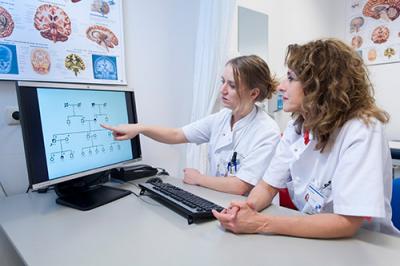G3-M10 Minor Translational Neuroscience
Overview of the program: Myasthenia gravis is an acquired autoimmune disorder with auto-antibodies attacking crucial membrane components of the neuromuscular junction. Immunogenetic, epigenetic, environmental factors affecting Myasthenia and its treatment will be discussed.
Huntington's disease is an autosomal inherited disorder caused by a CAG repeat in the Huntington gene and is characterized by involuntary movements, dementia and psychiatric symptoms. Mechanisms of the disease and social consequences for patients will be discussed.
Duchenne muscular dystrophy is a severe progressive neuromuscular disorder, which is caused by mutations in the dystrophin gene. Mechanisms causing Duchenne, palliative care, innovative therapies and clinical trials will be highlighted.
The eye and ear are organs that help in the interaction between the brain and the environment. Many diseases can affect vision and hearing. Various disease mechanisms and translational approaches will be discussed.
Limb Girdle Muscular Dystrophy (LGMD) and Facio-Scapulo-Humeral Muscular Dystrophy (FSHD) belongs to the Myopathies, which are rare diseases with often a genetic background. Patterns of muscle weakness and affecting factors will be highlighted.
Steroid and thyroid hormones act in the brain to affect behaviour and physiology. CNS disturbances caused by pituitary disease and exogenous steroids will be presented and analysed, and taken as examples for other hormone-related effects on brain.
Migraine is a severe common brain disorder characterized by throbbing headaches and neurological signs. Mechanisms underlying migraine, genetic factors and animal models will be discussed.
The brain changes its state for example from awake to sleep. Due to internal and external factors these states can also be affected leading to disease-associated situations such as narcolepsy, fainting, coma or psychosis. The latest developments in (pre-)clinical research on brain states will be discussed.
This topic will highlight the clinical and epidemiological picture of depression, a disorder affecting 10-20% of all people and its comorbidity with other diseases. Structural alterations in the depressed brain and the potential underlying mechanisms and environmental factors such as aberrant stress will be highlighted.
Loss of circadian rhythms has been associated with numerous diseases such as depression and sleep disturbances. This topic will highlight the function and role of the suprachiasmatic nucleus, the central clock in our brain and how environmental factors, i.e. (artificial) light, working shifts, may endanger the SCN thereby contributing to the pathogenesis of numerous brain disorders.
Teachers
Jeroen Briaire
Johan Frijns
prof.dr.ir. Wouter Serdijn
Circuits and systems for wearable, implantable and injectable medical devices, in particular electroceuticals and bioelectronic medicine.
dr. Vasiliki Giagka
Design and fabrication of active implantable devices; Analog and mixed-signal integrated circuits for biomedical applications
Last modified: 2020-05-27
